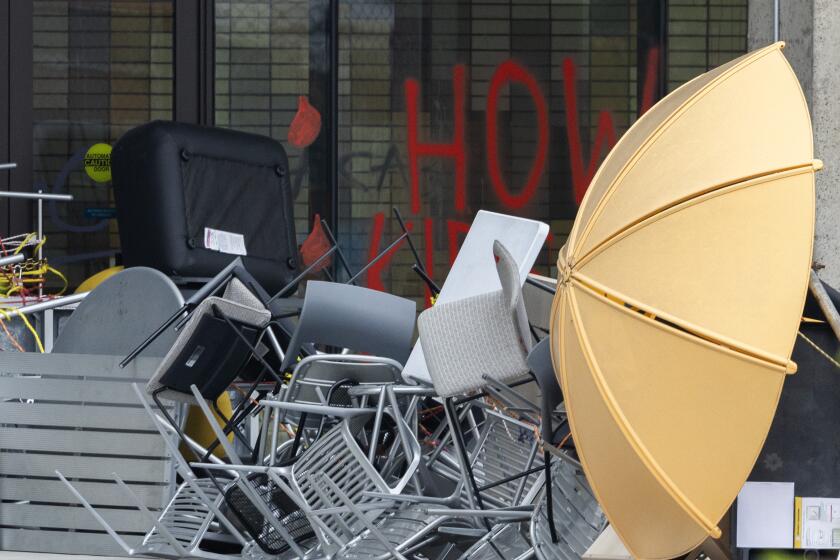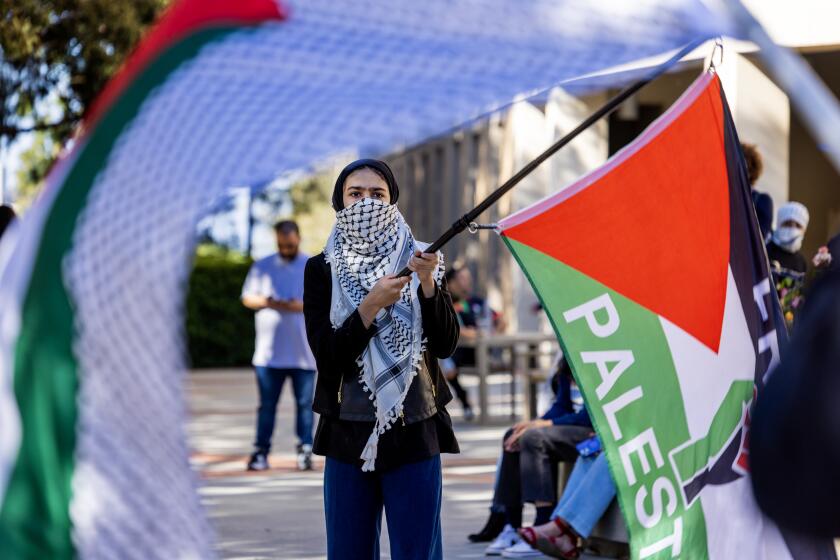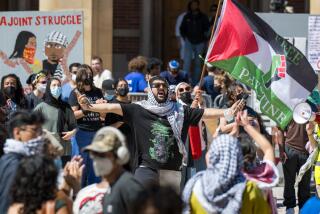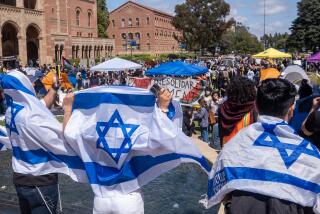Cal State L.A. encampment is shut down days after takeover of building with administrators inside
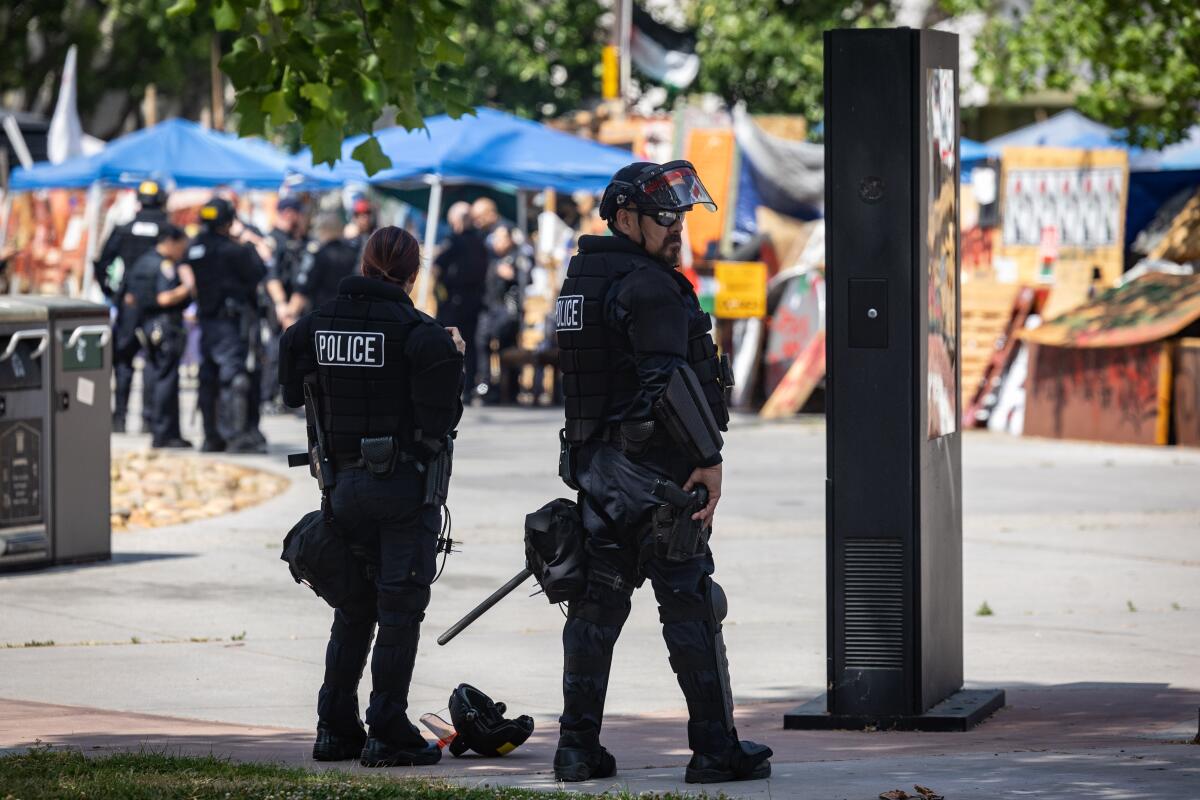
- Share via
Dozens of officers in riot gear from multiple agencies descended Monday afternoon on a pro-Palestinian encampment at Cal State L.A. to dismantle the camp and force protesters to leave after tensions escalated last week.
About 1:20 p.m., police issued a dispersal order in English and Spanish, and the remaining protesters in the encampment, a group of about 10, left voluntarily, said university spokesperson Erik Frost Hollins.
It was the last major pro-Palestinian protest encampment at a Los Angeles college.
Officers, who included those from the LAPD, California Highway Patrol and multiple Cal State campus police departments, did not use any weapons to remove protesters and made no arrests, Hollins said. Campus security and police blocked all road entrances to campus, although exits were open, and the campus was accessible by foot.
Using forklifts and large dumpsters, crews took down the painted and graffitied wooden boards that encircled the encampment and hauled them away. Many were painted in the red, green, white and black colors of the Palestinian flag and bore phrases including “Gaza Solidarity Encampment” and “Google LASD gangs.”
Students launched the camp on May 1 to demand that Cal State L.A. and the California State University system disclose its investments, “divest from companies that financially and materially support genocide, defend the Palestinian people’s rights of resistance and return, and declare that the genocide in Gaza and occupation of Palestine is illegal under international law,” according to a statement from the Students for Justice in Palestine at Cal State L.A.
Hollins said that, since the encampment launched, Cal State L.A. President Berenecea Johnson Eanes had visited it twice and held several conversations with protesters.
Questions about police response after pro-Palestinian protesters took over and barricaded the Cal State Los Angeles student services building.
While other universities, including USC and UCLA, moved in relatively quickly to shut down pro-Palestinian encampments over the spring, the one at Cal State L.A. was tolerated for many weeks. For the most part, it hasn’t been a site of heated controversy or clashes involving students, campus officials or police.
But the nature of the relationship between the university and protesters changed Wednesday, Hollins said, when several dozen protesters barricaded themselves inside the student services building, with some administrators inside, for more than nine hours. The Students for Justice in Palestine group said that administrators were free to leave, with escorts, whenever they desired. The group said it communicated that message directly and via Instagram. About 60 staffers were in the building for roughly two hours before exiting. Around a dozen, including Eanes and Hollins, voluntarily remained behind.
Hollins said there was no specific event on Monday that spurred the university to call in police but said officials had been talking about taking the encampment down since the building occupation.
On Monday afternoon, Eanes said in a campus-wide email that “those associated with the encampment engaged in unlawful acts that put staff and students” at risk during the building occupation, “including assault, vandalism, destruction of property, and looting.”
“The only acceptable option for the safety of the entire campus community was for the encampment to disband and disperse. We will not negotiate with those who would use destruction and intimidation to meet their goals,” she wrote. “It does not escape me that public employees serving a public mission at a public university in one of the region’s most under-resourced communities have been victimized by those claiming to protest injustice.”
Eanes said the campus, where classes have been virtual since the middle of last week, would continue virtually on Tuesday. The university is in its summer session, which ends Aug. 10.
On Monday, the Cal State L.A. chapter of Faculty for Justice in Palestine said it had remained concerned for weeks that the encampment might be compromised as negotiations stalled and frustrations mounted.
“While the protest of June 12th produced a turning point for the encampment, we propose that timely, good faith negotiations with the students over their divestment demands is the best route to a resolution,” the group said in a letter posted on Instagram. “We also recommend that you communicate more clearly with the encampment students about a timeline and process for decampment, rather than resort to an unannounced possible sweep that is likely to produce trauma, harm, and violence as it has at other universities.”
An Instagram post by Students for Justice in Palestine at Cal State L.A. showed a video of what appeared to be activists talking to police in riot gear who were gathered outside the camp’s barricades. “We have to do whatever they say,” a voice from the camp says in the background. “Can we leave?” an activist says to police as the activist looks out at law enforcement. “Yes!” several officers say in unison. “I want you to go,” an officer says. “I want less of you in there.”
The encampment was nearly dismantled by 5:30 p.m. Its removal revealed graffiti covering the wall below the “Olympic Fantasy” tile mural near the heart of campus, with slogans such as “Gaza lives” and “Stop funding genocide.”
The student services building, the site of last week’s occupation, remained closed off with police tape. Tables and chairs were turned over on its patio, and graffiti remained across its ground-level windows.
A campus security worker not authorized to speak to media said officials would clean up the building area after the camp materials were fully removed. They said they weren’t sure whether that would happen Monday.
Onlookers, including students and neighborhood residents, expressed surprise at the encampment’s removal and the police presence Monday.
“I did not agree with what the camp stood for, but I walked by it many times,” said James Wheeler, who walked over to the encampment area — cordoned off with yellow police tape — while a helicopter flew above.
“These were mostly peaceful students,” Wheeler said, “and their protest was nothing like the conflict or controversy you have seen at other colleges, aside from the one time they went to occupy the building.”
A student who said she knew members of the encampment said the police response was “way overblown” considering it was about 10 activists who voluntarily left the scene. “They sent in all these police cars, these riot police, blocked off the streets, all for nothing. It’s out of control,” said the student, who declined to share her name.
In her letter Monday, Eanes said the university would “need to confront the aftermath of sheltering inside [the student services building], the anger at the destruction of student spaces they worked so hard to create, and the grief of feeling less safe on a campus we all cherish.”
Tensions have escalated and arrests have been made as protesters continue to stake out areas on the campuses of many California universities, including UCLA, USC and Cal Poly Humboldt.
Hollins said, during the sit-in, one employee had “something thrown at their head,” while another was pushed into the door and then out of the way as protesters forced their way into the building.
Protesters vandalized the building heavily, Hollins said, and the university is still investigating to determine whether there should be arrests. Protesters covered their faces and took other steps to hide their identities, which complicates the investigation, they said.
Activists defended their actions.
“The defense of the sit-in and the Solidarity Encampment will continue despite heavy police pressure from the University Police Department, the Los Angeles Police Department, and the Los Angeles Sheriff’s Department until CSULA ends its financial and material support for genocide,” the group said in a statement last week.
Times staff writer Angie Orellana Hernandez contributed to this report.
More to Read
Sign up for Essential California
The most important California stories and recommendations in your inbox every morning.
You may occasionally receive promotional content from the Los Angeles Times.
